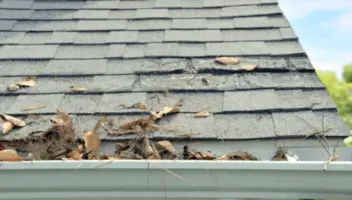How to Clean Gutters with Guards

Gutter guards can play a vital role in helping keep your gutters free of debris and clogs. In fact, LeafFilter’s gutter guards work so well, you won’t have to worry about cleaning out your gutters!
However, not all gutter guards have LeafFilter’s clog-free guarantee. If you installed another gutter guard system—even if you had it professionally installed—you may still need to clean out your gutters from time to time.
But when should you clean out your gutters if they have gutter guards? And what’s the best way to do it? Keep reading to find out!
In this article:
- When Do I Have to Clean Gutters with Gutter Guards?
- How to Clean Out Gutters with Guards (step by step)
- The 5 Types of Gutter Guards
- Final Thoughts
- Frequently Asked Questions
When Do I Have to Clean Gutters with Gutter Guards?
You may have hoped that installing gutter guards would take gutter cleaning off your to-do list. The good news is that if you choose the LeafFilter Gutter Protection System, you won’t have to worry about clogs inside your gutters again.
🌧️ Heavy rain and debris can wreak havoc on your gutters. But with LeafFilter, you can put your mind at ease! Our product is made to handle all kinds of weather and keep your gutters clear. 🌪 See how it works at: https://t.co/wRb2LmHWVN #leaffilter #gutterguards #stormproof pic.twitter.com/Eszw1gJciL
— LeafFilter Gutter Protection (@LeafFilter) June 30, 2023
Unfortunately, few gutter guards come with this type of guarantee. In most cases, you’ll still have to keep an eye out for signs that your gutters need cleaning.
Those signs may include the following:
- Water is overflowing and spilling over the sides of your gutters.
- Your siding has stain marks.
- Animals and pests are present in and around your gutters.
- Your gutters are sagging under the weight of debris.
- Plants, moss, or algae are growing in and around your gutters.
If you notice any of the above, it’s time to clean out your gutters and gutter guards. This can be disappointing if you hoped your gutter guards would prevent the buildup of debris that leads to clogs inside your gutters.
How to Clean Out Gutters with Guards (step by step)
Step 1: Prepare tools and inspect the area
Before you get started, gather everything you’ll need. Common tools include a ladder, gloves, a small hand rake or gutter scoop, a hose with a spray nozzle, a screwdriver (if your guards are screwed in), and a soft-bristle brush. A bucket for collecting debris can also come in handy.
Walk around your home and visually inspect the gutters and guards. Look for signs of overflowing water, sagging sections, or visible blockages like leaves and sticks on top. If you spot any nests or wasps in the eaves, take extra care or call a professional to remove them safely.
Step 2: Safely position the ladder and put on protective gear
Choose a stable, level surface and use a ladder stabilizer or helper if possible. Make sure the ladder extends 3 feet past the roof edge if you’ll be climbing onto the roof. If you can’t reach something, move the ladder instead of overreaching.
Wear gloves to protect your hands from sharp edges and dirty buildup. Safety glasses can help shield your eyes from debris, especially when using a hose or brush. If you’re working in a high-traffic area or near electrical lines, take extra precautions to stay safe and visible.
Step 3: Remove debris from above guards
Even with guards in place, leaves, pine needles, and small twigs can collect on top. Use your hand, a small scoop, or a soft brush to clear off any surface debris. This helps clear out any gathered debris to better ensure water can flow more freely into the gutter system.
Be gentle, especially with mesh or screen-style guards. Pushing too hard can bend or dislodge them. Focus on clearing away the heaviest buildup, especially near corners and downspout openings.
Step 4: Detach and rinse/brush gutter guards (if applicable)
If your gutter guards are removable, take them off one section at a time. Check the manufacturer’s instructions first. Some guards simply lift off, while others are fastened with screws or clips. Place each section on a tarp or solid surface.
Rinse the guards with a hose and use a soft-bristle brush to remove stuck-on grime or algae. Avoid harsh scrubbing or power washers, which can damage your guards. Let them dry fully before reattaching.
Step 5: Spray the gutters and downspouts
Once the guards are clean, use a hose to flush out the gutters. Spray toward the downspout to push any remaining debris through. Watch the flow, as slow drainage may mean there’s a clog in the downspout that needs to be cleared.
This is also a good time to check for any leaks or corrosion along the gutter seams. Minor issues can often be patched with gutter sealant.
Step 6: Reinstall and inspect
Reattach your gutter guards securely, following the same method used to remove them. Make sure each section lies flat and locks into place as gaps can allow debris back in or cause the guard to shift during heavy rain.
Do a final walkaround and inspect your work. Look for any missed spots, loose fittings, or signs of wear that could cause problems later. If everything looks good, you’re done—and your gutters are ready for the next downpour.
The 5 Types of Gutter Guards
When it comes to cleaning gutters with gutter guards, it depends on what type of gutter guards you have. Below, we break down the five most common types of gutter guards, with pros and cons such as their ease of cleaning and durability. This will help you to choose the guard type that is right for you.
Once your gutter guards are clean, you can proceed with cleaning out the gutters themselves.
Gutter Guard Comparison: What to Expect at Cleaning Time
| Type | Ease of cleaning | Tools you’ll need | Removal required? |
|---|---|---|---|
| Foam | Moderate. The foam blocks debris but also holds it inside the pores, so plan to rinse and replace every few years. | Ladder, gloves, garden hose or low-pressure washer | Yes. Lifting the inserts out lets you flush them thoroughly. |
| Brush | Moderate to difficult. Bristles trap pine needles and seeds, which can be stubborn to shake loose. | Ladder, gloves, garden hose or pressure washer | Yes. Removing the brushes makes it easier to shake out debris and rinse clean. |
| Screen | Easy. Most leaves sit on top and hose off quickly, though screens can lift in strong winds. | Ladder, gloves, garden hose | Usually. Popping the panels off lets you clear anything that fell into the gutter beneath. |
| Mesh / Micro-Mesh | Moderate. Fine openings stop shingle grit and pollen but can gather on the surface, so a light brush or rinse twice a year keeps water flowing. | Ladder, gloves, soft-bristle brush, garden hose | Sometimes. Plastic mesh often lifts out; metal mesh is usually fixed in place. |
| Surface Tension (Reverse Curve) | Easy. Most debris slides away on its own; a quick rinse now and then is plenty. | Ladder, soft brush, garden hose | No. These systems stay mounted and are cleaned from above. |
Foam Gutter Guards
Foam guards sit inside your gutter and work by blocking debris while letting water flow through the porous material. They’re lightweight, inexpensive, and easy to install. Because they fit snugly into the gutter, they work well with homes that receive moderate leaf fall and limited roof runoff.
That said, foam can degrade over time and is prone to moss or mildew if it stays damp. They’ll need to be lifted out occasionally to clear out debris or rinse away buildup. Homeowners should expect to replace them every few years as part of routine maintenance.
Brush Gutter Guards
Brush-style guards look a bit like giant pipe cleaners. They sit inside the gutter and catch debris in their bristles while letting water pass around and through. They’re similarly easy to install and affordable, with the added benefit of being flexible enough to bend around corners and oddly shaped gutters.
However, those same bristles can trap pine needles, seeds, and other fine debris, which may require more frequent cleaning than other types. They work well for homes with minimal tree coverage or for short-term protection during heavy leaf seasons.
Screen Gutter Guards
Screen guards are made from lightweight plastic or aluminum and rest directly on top of your gutters. They block larger debris like leaves and twigs, while allowing rainwater to pass through the holes. These are a common middle-ground option that are affordable, easy to remove, and suitable for moderate climates.
Unfortunately, they can shift or blow loose during storms, especially if they aren’t fastened down. Over time, debris can pile up on top or work its way through the holes. Homeowners should plan to lift and clear them out at least once or twice a year, especially after fall or strong winds.
Mesh Gutter Guards
Mesh guards come in handy if you want something sturdier than a screen without going all-in on high-end options. You’ll see them in metal or plastic, both with small holes meant to catch leaves and bits of roof debris. Metal mesh usually stays put once installed. Plastic versions are easier to remove but not quite as tough, especially after a few seasons in the sun.
These guards do a decent job, but they’re not perfect. Smaller stuff – like pollen or gritty dust – can still sneak through. If that’s a concern where you live, you might want to look into micro-mesh systems instead.
Either way, mesh guards aren’t a “set it and forget it” solution. Leaves can sit on top, or junk can build up underneath. If you ever spot water pouring over the sides, that’s your sign that it’s time to take a look and clean things out.
Micro-Mesh Gutter Guards
Micro-mesh systems like the ones from LeafFilter offer some of the best debris protection, with ultra-fine holes that block even shingle grit and pollen. These guards are typically made from stainless steel or aluminum and are securely attached to the gutter system, often with a frame that increases strength and water flow.
They’re ideal for homes with a variety of weather and foliage conditions, from leafy areas to regions with high pollen or dust. That fine mesh also means surface buildup is more likely. Occasional brushing off or rinsing is typically enough to keep them working efficiently, though a full inspection is recommended after storms or seasonal changes.
Surface Tension (Reverse Curve) Gutter Guards
These are high-end systems designed to take advantage of water’s natural surface tension. Water flows along the curved guard and into the gutter, while debris is deflected and drops to the ground.
They work well in heavy rain and rarely clog, but they come at a higher price point and aren’t meant to be removed for DIY cleaning. Still, grime can collect over time, both on top and underneath. Occasional rinsing and inspection are required to maintain peak performance. Because the system is integrated into the roofline, most homeowners opt to have pros handle any in-depth servicing.
Final Thoughts
You may have noticed that in most of the situations above, it’s necessary to climb a ladder to clean out your gutter guards. This can be risky, as according to the American Ladder Institute, 500,000 people are treated every year for ladder-related injuries.
You can hire a professional to clean out your gutters, or you can choose to have our LeafFilter Gutter Protection System professionally installed by our local gutter pros. Our patented, award-winning technology can help prevent the smallest debris from entering your gutters—including pollen—and comes with a limited lifetime transferable warranty. While occasional surface cleaning may still be needed, you won’t have to worry about constant digging and clog cleaning from inside your gutters.
Call us today at 1-844-970-1750 to learn why over a million customers nationwide have trusted LeafFilter to help protect their homes.
Frequently Asked Questions
Should I clean out gutters with gutter guards?
It’s best to clean your gutter guards (and clean out your gutters) at least twice per year. In between cleanings, check them periodically to make sure water is still flowing freely.
How do you clean the top of gutter guards?
It depends on the type of guard and the height of your roof. For single-story homes, you may be able to clean screen, mesh, or surface tension guards from the ground using a leaf blower, wet/dry vacuum, or a hose or pressure washer attachment. Just be sure to use low pressure to avoid damaging the guards – high-pressure spray can bend screens or dislodge mesh. For taller homes or stubborn debris, it’s safer to use a ladder or call a professional.
Why does water run over my gutter guards?
If you notice water running over your gutter guards, you may have debris buildup, and you’ll need to assess where the debris needs to be cleared or cleaned.
How do you remove leaves from the top of gutter guards?
You can climb a ladder and spray the leaves off, but it’s safer to work from the ground. Try using a leaf blower attachment to blow dry leaves away. If the leaves are wet, try using a wet/dry vacuum or pressure washer attachment to clear them off of your gutter guards.
How do you clean gutters without climbing a ladder?
It’s always best to call a professional for cleaning gutter guards. However, if you choose to a DIY solution and your home is only one story high, you can use gutter-cleaning attachments for a leaf blower, wet/dry vacuum, or garden hose to remove debris from the top of guards or rinse out gutters. These tools work best on screen, mesh, or surface tension guards that don’t need to be removed. Always use low pressure, and avoid high-powered washers that could damage your guards. If your home is more than one story tall (or your guards need to be taken off to clean underneath), it’s safest to call a professional.


